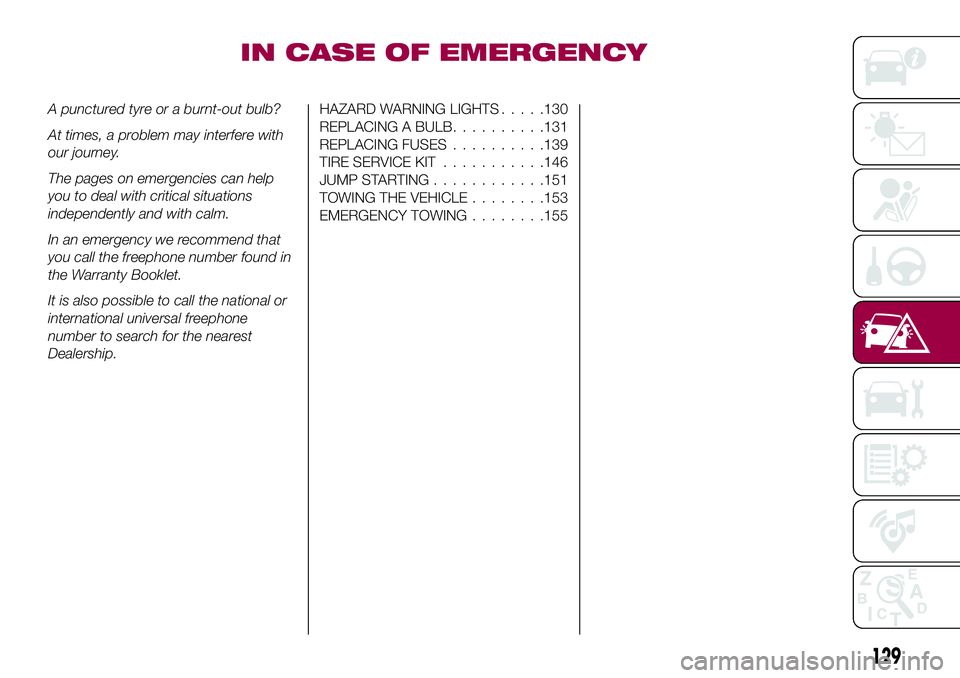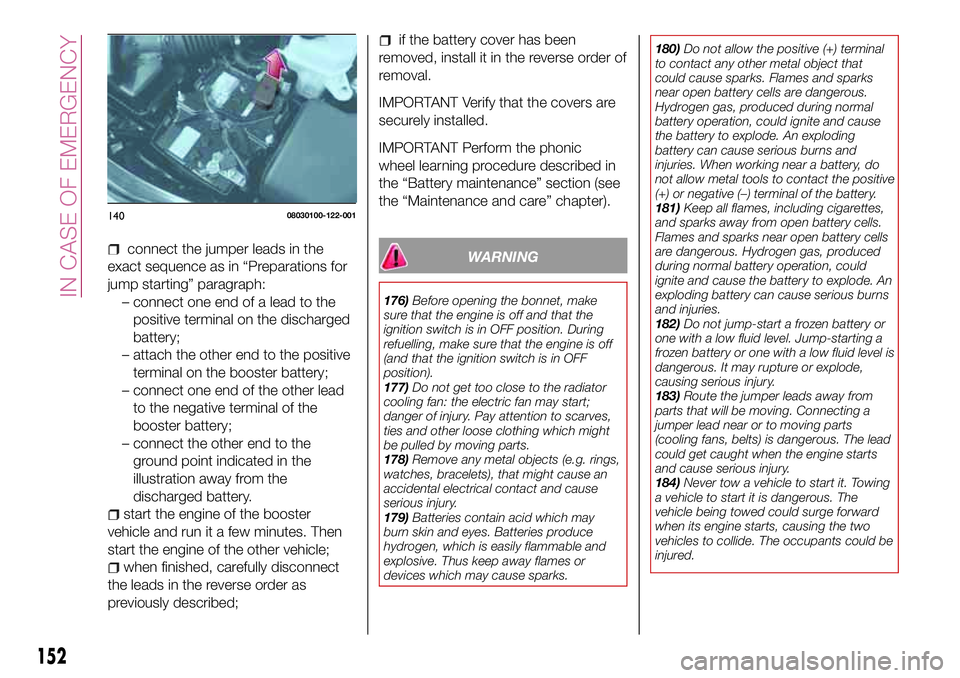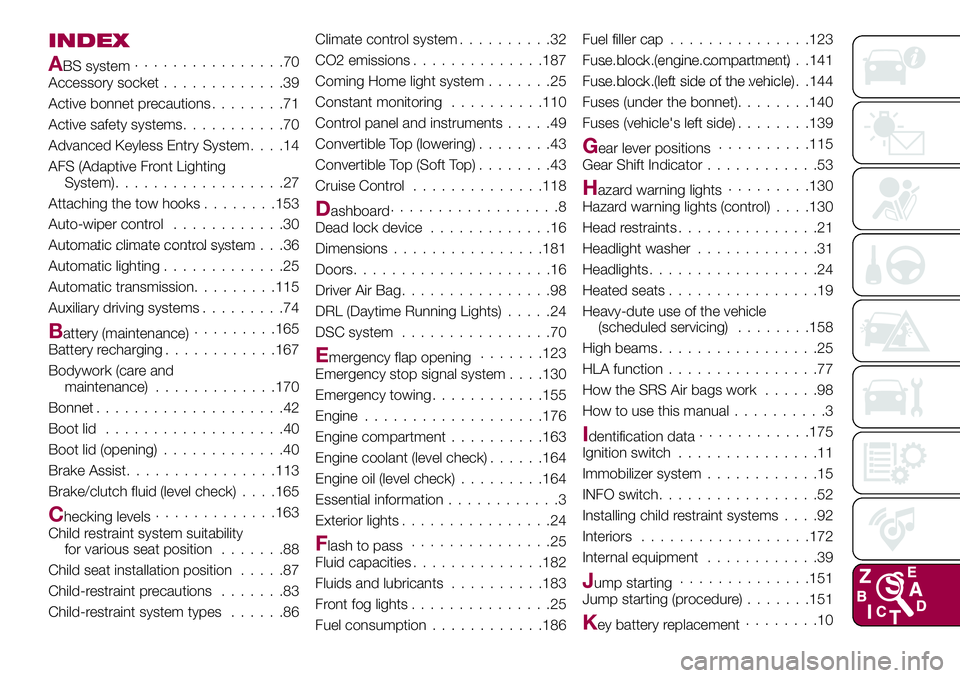jump start FIAT 124 SPIDER 2018 Owner handbook (in English)
[x] Cancel search | Manufacturer: FIAT, Model Year: 2018, Model line: 124 SPIDER, Model: FIAT 124 SPIDER 2018Pages: 220, PDF Size: 3.18 MB
Page 62 of 220

Amber warning lights
Warning light What it means
ABS WARNING LIGHT
If the ABS warning light stays on while you're driving, the ABS control unit has detected a
system malfunction. If this occurs, your brakes will function normally as if the vehicle had no
ABS. Should this happen contact a Fiat Dealership as soon as possible.
NOTE When the engine is jump-started to charge the battery, uneven rpm occurs and the ABS
warning light may illuminate. If this occurs, it is the result of the weak battery and does not
indicate an ABS malfunction. Recharge the battery.
NOTE The brake assist system does not operate while the ABS warning light is illuminated.
CHECK ENGINE LIGHT
If this light illuminates while driving, the vehicle may have a problem. It is important to note the
driving conditions when the light illuminated and contact a Fiat Dealership.
The check engine light may illuminate in the following cases:
the engine's electrical system has a problem;
the emission control system has a problem;
the fuel tank level being very low or approaching empty;
the phonic wheel learning, following disconnection of the battery, did not complete
successfully.
60
KNOWING THE INSTRUMENT PANEL
Page 131 of 220

IN CASE OF EMERGENCY
A punctured tyre or a burnt-out bulb?
At times, a problem may interfere with
our journey.
The pages on emergencies can help
you to deal with critical situations
independently and with calm.
In an emergency we recommend that
you call the freephone number found in
the Warranty Booklet.
It is also possible to call the national or
international universal freephone
number to search for the nearest
Dealership.HAZARD WARNING LIGHTS.....130
REPLACING A BULB..........131
REPLACING FUSES..........139
TIRE SERVICE KIT...........146
JUMP STARTING............151
TOWING THE VEHICLE........153
EMERGENCY TOWING........155
129
Page 153 of 220

JUMP STARTING
PREPARATIONS FOR
JUMP STARTING
176) 177) 178) 179) 180) 181) 182) 183) 184) 185)
34)
Jump-starting is dangerous if done
incorrectly. So follow the procedure
carefully fig. 139. If you feel unsure
about jump-starting, we strongly
recommend that you have a competent
service technician do the work.
IMPORTANT When using booster
battery is used, comply with the
utilisation and precaution instructions
specified by the producer.
IMPORTANT Do not use the booster
battery or any other source of external
supply with a voltage above 12 V: the
battery, the starter, the alternator and
the electrical system of the vehicle
could be damaged. You can damage a
12 V starter, ignition system, and other
electrical parts beyond repair with a
24 V power supply (two 12 V batteries
in series or a 24 V motor generator set).IMPORTANT Do not attempt jump
starting if the battery is wet. The battery
could break and explode!
JUMP-STARTING
PROCEDURE
IMPORTANT If the procedure below is
carried out incorrectly can cause severe
injuries to people or damage the
recharging system of one or both
vehicles. Carefully follow the
instructions given below.
Proceed as follows to carry out a jump
starting:
remove the battery cover fig. 140;
make sure the booster battery is
12 V and that its negative terminal is
grounded;
if the booster battery is in another
vehicle, do not allow both vehicles to
touch. Turn off the engine of the vehicle
with the booster battery and all
unnecessary electrical loads in both
vehicles;
13908030100-121-001
151
Page 154 of 220

connect the jumper leads in the
exact sequence as in “Preparations for
jump starting” paragraph:
– connect one end of a lead to the
positive terminal on the discharged
battery;
– attach the other end to the positive
terminal on the booster battery;
– connect one end of the other lead
to the negative terminal of the
booster battery;
– connect the other end to the
ground point indicated in the
illustration away from the
discharged battery.
start the engine of the booster
vehicle and run it a few minutes. Then
start the engine of the other vehicle;
when finished, carefully disconnect
the leads in the reverse order as
previously described;
if the battery cover has been
removed, install it in the reverse order of
removal.
IMPORTANT Verify that the covers are
securely installed.
IMPORTANT Perform the phonic
wheel learning procedure described in
the “Battery maintenance” section (see
the “Maintenance and care” chapter).
WARNING
176)Before opening the bonnet, make
sure that the engine is off and that the
ignition switch is in OFF position. During
refuelling, make sure that the engine is off
(and that the ignition switch is in OFF
position).
177)Do not get too close to the radiator
cooling fan: the electric fan may start;
danger of injury. Pay attention to scarves,
ties and other loose clothing which might
be pulled by moving parts.
178)Remove any metal objects (e.g. rings,
watches, bracelets), that might cause an
accidental electrical contact and cause
serious injury.
179)Batteries contain acid which may
burn skin and eyes. Batteries produce
hydrogen, which is easily flammable and
explosive. Thus keep away flames or
devices which may cause sparks.180)Do not allow the positive (+) terminal
to contact any other metal object that
could cause sparks. Flames and sparks
near open battery cells are dangerous.
Hydrogen gas, produced during normal
battery operation, could ignite and cause
the battery to explode. An exploding
battery can cause serious burns and
injuries. When working near a battery, do
not allow metal tools to contact the positive
(+) or negative (–) terminal of the battery.
181)Keep all flames, including cigarettes,
and sparks away from open battery cells.
Flames and sparks near open battery cells
are dangerous. Hydrogen gas, produced
during normal battery operation, could
ignite and cause the battery to explode. An
exploding battery can cause serious burns
and injuries.
182)Do not jump-start a frozen battery or
one with a low fluid level. Jump-starting a
frozen battery or one with a low fluid level is
dangerous. It may rupture or explode,
causing serious injury.
183)Route the jumper leads away from
parts that will be moving. Connecting a
jumper lead near or to moving parts
(cooling fans, belts) is dangerous. The lead
could get caught when the engine starts
and cause serious injury.
184)Never tow a vehicle to start it. Towing
a vehicle to start it is dangerous. The
vehicle being towed could surge forward
when its engine starts, causing the two
vehicles to collide. The occupants could be
injured.
14008030100-122-001
152
IN CASE OF EMERGENCY
Page 215 of 220

INDEX
ABS system................70
Accessory socket.............39
Active bonnet precautions........71
Active safety systems...........70
Advanced Keyless Entry System....14
AFS (Adaptive Front Lighting
System)..................27
Attaching the tow hooks........153
Auto-wiper control............30
Automatic climate control system.......................36
Automatic lighting.............25
Automatic transmission.........115
Auxiliary driving systems.........74
Battery (maintenance).........165
Battery recharging............167
Bodywork (care and
maintenance).............170
Bonnet....................42
Boot lid...................40
Boot lid (opening).............40
Brake Assist................113
Brake/clutch fluid (level check). . . .165
Checking levels.............163
Child restraint system suitability
for various seat position.......88
Child seat installation position.....87
Child-restraint precautions.......83
Child-restraint system types......86Climate control system..........32
CO2 emissions..............187
Coming Home light system.......25
Constant monitoring..........110
Control panel and instruments.....49
Convertible Top (lowering)........43
Convertible Top (Soft Top)........43
Cruise Control..............118
Dashboard..................8
Dead lock device.............16
Dimensions................181
Doors.....................16
Driver Air Bag................98
DRL (Daytime Running Lights).....24
DSC system................70
Emergency flap opening.......123
Emergency stop signal system. . . .130
Emergency towing............155
Engine...................176
Engine compartment..........163
Engine coolant (level check)......164
Engine oil (level check).........164
Essential information............3
Exterior lights................24
Flash to pass...............25
Fluid capacities..............182
Fluids and lubricants..........183
Front fog lights...............25
Fuel consumption............186Fuel filler cap...............123
Fuse block (engine compartment)......................141
Fuse block (left side of the vehicle)......................144
Fuses (under the bonnet)........140
Fuses (vehicle's left side)........139
Gear lever positions..........115
Gear Shift Indicator............53
Hazard warning lights.........130
Hazard warning lights (control). . . .130
Head restraints...............21
Headlight washer.............31
Headlights..................24
Heated seats................19
Heavy-dute use of the vehicle
(scheduled servicing)........158
High beams.................25
HLA function................77
How the SRS Air bags work......98
How to use this manual..........3
Identification data............175
Ignition switch...............11
Immobilizer system............15
INFO switch.................52
Installing child restraint systems....92
Interiors..................172
Internal equipment............39
Jump starting..............151
Jump starting (procedure).......151
Key battery replacement........10